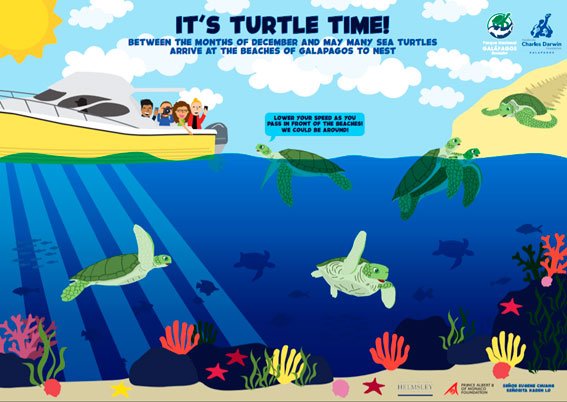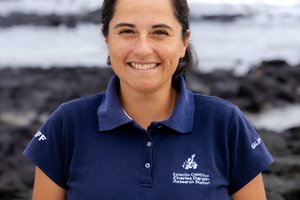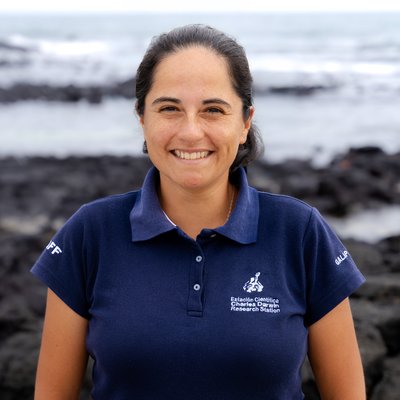Immerse yourself in a new adventure guided by the green sea turtles (Chelonia mydas) of the Galapagos Marine Reserve and explore with us their exciting and intriguing lives.
Our scientists are working on a project that aims to reduce the threat of boat strikes on green turtles in Galapagos. As part of their research, they installed multisensory devices on female green turtles starting in January of this year, to better understand their behavior in the ocean.
The devices recorded several hours, providing a unique experience of observing the natural behavior of the turtles. We identified several interesting behaviors, in addition to regular actions such as sleeping and swimming, the interaction between turtles, encounters with other animals and, most interesting for our scientists, their encounter with boats.
Here we share with you the best shots and stories recorded by one of the sea turtles:

Resting time
Laying a total of 141 eggs marked the end of their nesting cycle. Which lasted around 3 hours. Equipped with a multi-sensory device, she safely returned to the sea.
The next day the camera recorded from 07:00 to 18:00 at intervals of 10 minutes, recording 5 hours in total. During the first day of monitoring the sea turtle spent time sleeping and resting approximately 3 hours of all recording time, on the sandy ocean floor.
Breathing
Sea turtles have an incredible ability to hold their breath underwater, which helps them perform long and deep dives. They can last up to an hour or more if they are completely inactive. Conversely, they need to come up and breathe more often if they are swimming or feeding.
During the second day of recording, the turtle remained more active and in the 3 hours of recording, while she was swimming, we saw her come up 70 times to breathe.
A solitary life
Sea turtles are not social animals. Adults don’t know or care for their offspring, they do not form groups to migrate, and do not interact with each other even when at a popular feeding site, like coastal areas, where many turtles can be found.
However, during the nesting season, it is common to see males and females interacting during courtship and mating.
Our monitored turtle visited sites near her nesting beach, where she met other turtles and even saw some males approaching her to try and mate.
Neighbors
During their long and dynamic life cycle, green turtles use a wide variety of habitats during their lifetime. Adult turtles spend most of their time in shallow coastal areas, keeping them close to their food source of green algae. Living in such plentiful locations means that they have to share this habitat with other marine species, such as fish, sea lions and reef sharks.
Thanks to the device we installed on this female turtle, we were able to observe the different habitats she visited, as well as the diversity of "neighbors" with who she shared peacefully.
Visiting the Surface
Sea turtles are frequent visitors to the sea surface. Not only do they go up for air, but as they can’t regulate their body temperature, they spend time on the surface to "sunbathe" which increases their temperature. It's also common to see them mating on the surface during nesting season, or by taking a look to orient themselves.
Our monitored turtle was recorded several times spending time on the surface, resting, “sunbathing” and surprisingly mating.
Feeding Time!
Green turtles are generally herbivorous. Adults feed mostly on grass and seaweed. Its jaw is sown with a wide bill which helps to rip and scrape the vegetation. This diet is the one that gives the green color, thus providing its name, “green turtles”. Juveniles however have a more varied diet and feed on crabs, sponges and jellyfish.
Here's a green turtle giving you a healthy feast of algae on the reef on Darwin Island.
Interaction with boats
The work carried out by our scientist in 2013, has revealed that about 12% of the sea turtles that nested at Quinta Playa during that year, they had injuries caused by interaction with boats. This is because many of the sea turtle aggregation sites are close to areas of busy marine transit.
Las Bachas, the nesting beach from where our turtle was monitored, is located in an area of high marine traffic, mainly due to tourism. We watched our turtle swim near boats on several occasions during the monitored days.
Our message for boats is to slow down when navigating near beaches and other sea turtle aggregation sites because there could be turtles in the area.
Our commitment to education and community outreach
As part of our work, we have been developing several outreach materials. Here is an example of a poster we recently produced and distributed in the community to raise awareness.

This study is possible due to the support of our generous donors at IGTOA, Galapagos Conservancy Canada, Prince Albert II of Monaco Foundation, Ecoventura, CONICYT, Ms. Karen Lo, and our partnerships with Queen’s University Belfast and Galapagos National Park Directorate.
If you want to contribute to our work, please visit: https://www.darwinfoundation.org/en/get-involved/give/donate






